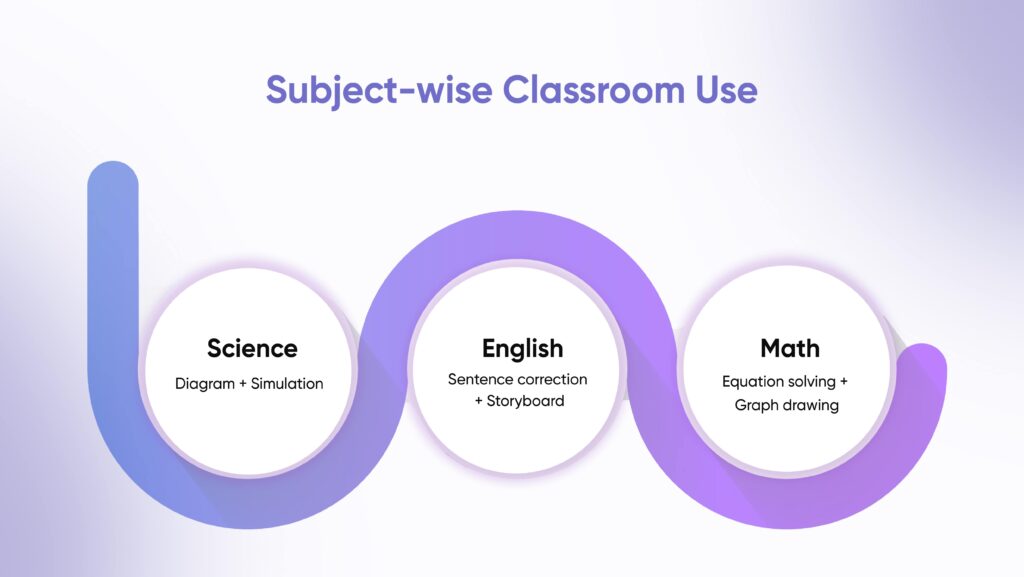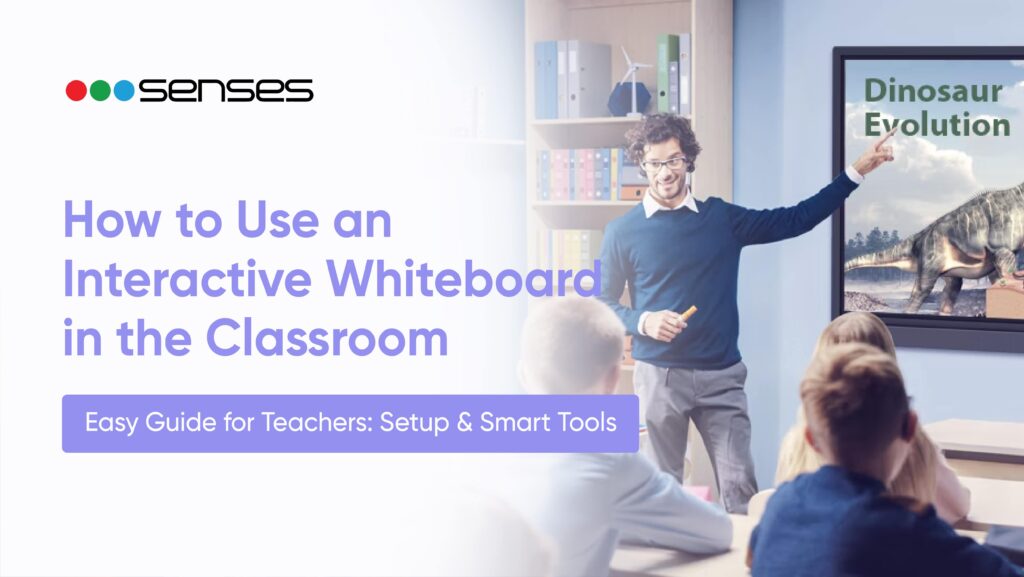In today’s time, interactive whiteboards are transforming teaching methods in Indian schools. Teachers are more inclined towards how to use interactive whiteboards in the classroom as compared to traditional methods.
And knowing how an interactive whiteboard works, they are ready to maximise its potential and create a dynamic learning environment. Interactive whiteboards can easily plan lessons, take notes, display videos, and engage with students in one application.
Whereas traditional blackboards have limitations. So, if you’re interested in making your school more tech-friendly, connect with Senses Electronics today and transform your classroom.
Key Takeaways:
- In Indian classrooms, there are smart boards that are taking the place of old white and green boards for their touch capability, multimedia capabilities, and interactive features.
- They provide teachers with a platform to deliver their lessons visually, and they allow students to participate directly on the board to help enhance learning.
- Senses Electronics has a variety of smart board models available specifically for Indian schools; several have Android OS, cloud storage capabilities, a dual OS platform, and can record the content on the board.
What is an Interactive Whiteboard?
An interactive whiteboard is a digital display that permits users to write, draw, move objects, and interact with content displayed on a touch-sensitive screen, making teaching and learning more interesting.
The interactive whiteboards are either connected to a computer or they have an operating system (like Android) built in. Teachers can display lessons using multimedia and use their fingers or a stylus to write on the board, as well as save their notes to share with students later.
Key Features:
Interactive whiteboards provide many features that help teachers teach well:
- Use of Multimedia: If teachers want Indian students to learn well, they can incorporate many different types of features: web pages, videos, PDFs, and others, etc.
- Touchscreen: Users may be able to collaborate directly with the content on the interactive whiteboard surface using a stylus or finger.
- Annotations: either students or teachers may draw any type of diagram or image, interact with text, or write equations on the board.
- Save and Share: Teachers can distribute a digital snapshot of the board to others.
- Multiple users: students can collaborate effectively, as learning assumes a different dimension when multiple students can write on a board together.
How Does an Interactive Whiteboard Work?
Interactive whiteboards function by recognising touch input via infrared or capacitive sensors. Once paired with a computer (or even via a built-in operating system), the interactive whiteboard can mirror your screen. From the board, you can open applications, utilise whiteboard tools, or browse using Internet applications.
For example, Senses Electronics smartboards utilise 4K touchscreens with multi-touch capabilities, although they also have an Android operating system, allowing seamless navigation for interactive teaching without independent laptops.

How to Use an Interactive Whiteboard in the Classroom
Interactive whiteboards are versatile. They can be employed for lesson delivery, engagement, notemaking, or multimedia exploration to help facilitate a rich and interactive teaching environment.
Let’s take a look at how teachers can get maximum value from this technology within real classroom environments.
1. Present Multimedia Lessons
Educators can display video lectures, showcases, infographics, web pages, etc. on the screen. This visual format for teaching helps teachers better explain complicated ideas rather than creating them with traditional text or using a blackboard.
For instance, you could stream an instructional video that demonstrates chemical reactions or simulations during a science class. When learning is presented to students, they are more likely to comprehend it.
2. Write, Draw, Highlight Instantly
Educators can write, underline, or utilise whiteboards to showcase their annotations directly on presentations, diagrams, or blank screens using their finger or stylus. You can work through math problems, underline with different colour highlighters, or draw timelines, all while focused on your class.
The tactile experience helps students retain their lessons, is visually meaningful, and enables them to follow along.
3. Encourage Student Involvement
In addition to having students work problems on the board, drag and drop answers, or write their input to brainstorming sessions, interactivity works to engage students and provide a sense of ownership.
For example, schools that utilise Senses smart boards use them to provide small group activities so students can work directly on the smart board and collaborate with classmates on it.
4. Save and Reuse Lesson Content
The smart board allows you to save your session, including all handwritten notes and diagrams, and your session can be forwarded for students who may have missed it earlier, or you may want to revisit the session at a later date and not have to recreate it.
This is a particularly useful tool for you to use for revision prior to an exam or midterm; you can save time for your students and yourself.
How to Set Up a Smart Interactive Whiteboard
Establishing a smart board is a simple task that can be accomplished by those who have a basic knowledge of technology or through the assistance of a vendor. Interactive whiteboards typically require power, connection to a display, and calibration before you can use them.
Step-by-Step Setup
Step 1: Unbox & Mount: Fasten the board to a wall or stand.
Step 2: Connect Hardware: Connect it to a power source and a computer or Wi-Fi.
Step 3: Install Drivers or Software: Most boards have drivers or options to install drivers automatically.
Step 4: Calibrate the Screen: Adjust the touch sensitivity and screen alignment.
Step 5: Check for Functionality: Open apps, test multimedia, and try drawing.
Senses Electronics offers free setup assistance and on-site training for teachers, which ensures the board is installed properly and ready to use from day one.
Practical Teaching Applications of Interactive Whiteboards
Teachers can modify smart boards to meet the needs of their curricula because they support a variety of teaching philosophies in all subject areas.
Let’s look at subject-wise applications.
For Science and Math
- Draw chemical structures, formulas, and graphs.
- Use simulations to explain complex reactions or natural phenomena.
- Solve equations step-by-step on the board.
For Languages and Humanities
- Highlight grammar rules or sentence formation live.
- Explore maps and historical timelines.
- Conduct digital storytelling or reading sessions.
For Primary Education
- Use rhymes, songs, and colourful visuals.
- Drag-and-drop games to teach the alphabet or numbers.
- Simple drawing tools to encourage creativity.
Boards like those from Senses Electronics come with preloaded education apps aligned with Indian school syllabi, making lesson planning effortless.

Benefits of Using Interactive Whiteboards in the Classroom
Interactive boards combine visuals and hands-on learning to enhance classroom productivity, student focus, and lesson delivery.
Schools using Senses smart boards in classroom have achieved significant increases in student confidence and academic ability and understanding in test conditions in just one term.
Here’s how they benefit modern classrooms:
- Visual and Kinaesthetic Learning Support: Learners who are more visual or kinaesthetic learn from animations, virtual drawing tools, and interactive sessions.
- Complexity Simplified: Videos, pictures, diagrams, and annotations make complex ideas easier to understand, like grammar rules and physics theories that initially appear overwhelming.
- Re-Use to Save Time: Teachers do not have to recreate the same experience each year. Just load, update, and teach!
- Collaboration and Inclusivity: Shy students are more willing to engage when using participatory media and exploratory tools. Group assignments that use multi-user tools are easier to complete successfully.
How Much Does an Interactive Whiteboard Cost?
Pricing depends on display size, resolution, operating system, and built-in features. Here’s a quick breakdown.
- Infrared Smart Boards: Affordable and widely used.
- Capacitive Touch Boards: Highly responsive, similar to smartphones.
- 4K UHD Smart Boards: Offer ultra-clear visuals.
- Dual OS Boards: Combine Android and Windows platforms for flexibility.
Entry-Level Models
- Cost: ₹55,000 and ₹90,000
- Features: Basic display, touch support, and wired connectivity
- Ideal for: Budget-conscious schools
Mid-Range Smart Boards
- Cost: ₹80,000 to ₹246,000
- Features: Android OS, HD display, Wi-Fi support
- Ideal for: Most Indian schools and coaching centers
Premium Panels
- Cost: ₹120,000 – ₹250,000+
- Features: 4K display, 20-point touch, cloud integration, AI tools
- Ideal for: High-tech classrooms, private schools, and training centers
Note: Senses Electronics provides flexible pricing and configuration options, making smart classrooms accessible even for smaller schools.
How Interactive Whiteboards Compare with Traditional Tools
Interactive whiteboards outperform traditional blackboards or whiteboards in flexibility, reusability, and engagement.
| Feature | Interactive Whiteboard | Traditional Board |
| Writing Tools | Finger/Stylus | Chalk/Markers |
| Reusability | Save & Reuse | Manual rewriting |
| Multimedia Support | Yes | No |
| Engagement | High | Low |
| Student Interaction | Multi-user & Collaborative | One-way |
Key Features to Look for When Buying an Interactive Whiteboard
Not all boards provide equal value. These essential features can assist schools in selecting the best smart board for the classroom.
- Touch Precision and Multiple-User Support: Select a board with a minimum of 10 points of touch so multiple students can use it simultaneously without lag.
- Display Quality (Full HD or 4K): Look for anti-glare, bright displays that are visible in the sun. A screen size of 65″–86″ is ideal for a majority of classrooms.
- Built-in Operating System: Boards that have an Android and/or Windows inbuilt OS, provide flexibility for educational applications.
- Software Support and Warranty: Connect with vendors like Senses Electronics that provide a lifetime software license, cloud backup, and responsive customer support so you do not find yourself struggling after making a purchase.

Conclusion
Interactive whiteboards are more than just devices; they’re critical tools for learning in the 21st century. They make lessons dynamic, students responsive, and teaching impactful. Whether you are a teacher, principal, or school employee, it’s time to implement interactive learning in your classroom
By choosing Senses Electronics, reliable solutions, schools can ensure they will always have the best tools available to them while ensuring budgetary constraints will not be exceeded.
FAQs
1. What is an interactive whiteboard?
An interactive whiteboard is a large, touch-enabled screen that a user can interact with right away by writing or drawing on it. As it recognises touch, it displays content from an internal Android system or external computer it is connected to.
2. How might teachers use it?
Teachers might display a video or annotate a document on the board. They might also solve a math problem or engage the entire class in a quiz and get everyone organised to work collaboratively during the lesson.
3. Is it difficult to set up?
No, most smart boards are plug-and-play. Mount the board, connect it to power, and then calibrate it. Senses Electronics also provides on-site installation as well as training for teachers and administrators.
4. What is the best Senses Electronics model?
For type spaces, consider the larger 75″ or 86″. If you are a school system and are predominantly using Windows OPS, consider using the Senses Pro 86″ OPS.

